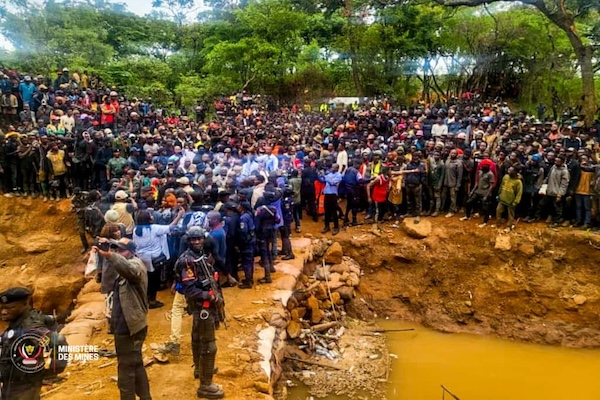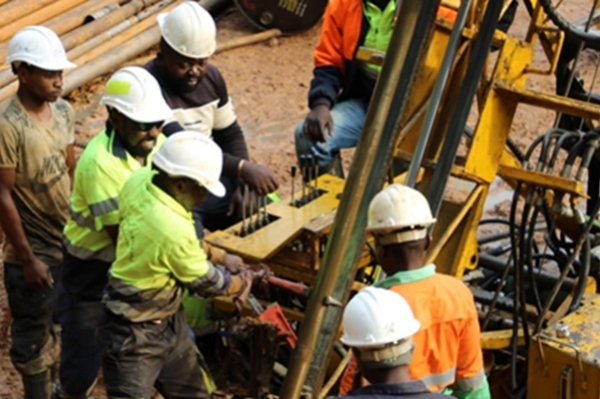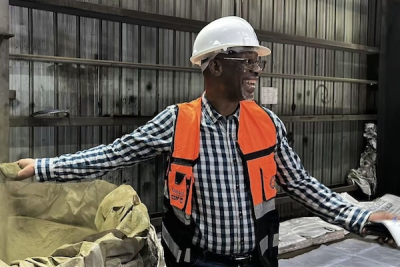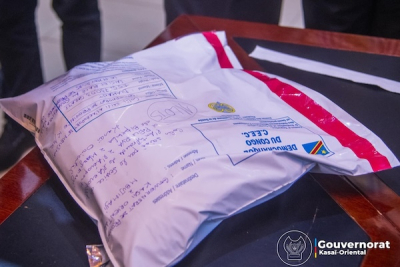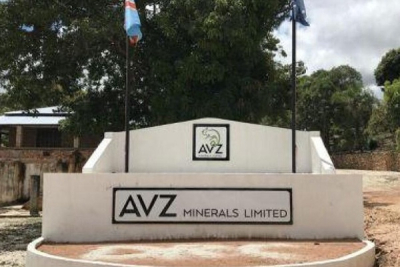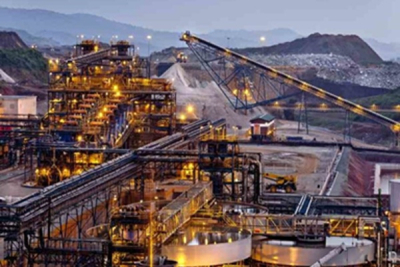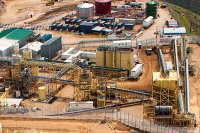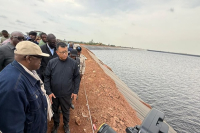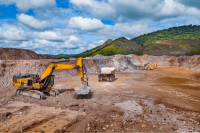
MINING (162)
The Democratic Republic of Congo's mines minister announced the creation of 64 artisanal mining zones on Monday, Nov. 17.
The announcement was made during a crisis meeting in Kolwezi, held two days after a November 15 accident at the Kalando mine that killed around 40 artisanal miners.
"I can officially tell you today that at least 64 artisanal mining zones have been cleared for you," Mines Minister Louis Watum Kabamba said.
Identifying these zones was the first part of a plan presented by President Felix Tshisekedi during a June 13 council of ministers meeting to curb "the perverse effects denounced in artisanal mining" in Lualaba province, as soon as possible."
Among the problems identified by the head of state was the invasion of industrial mining concessions by artisanal miners, generating cohabitation tensions. The Kalando site is one example. Located 42 kilometers southeast of Kolwezi, it sits on a permit (PE 2116) belonging to Chemical of Africa (Chemaf), which said it ceded the permit to Pajeclem Congo Consulting Sarl on July 21. Artisanal miners access it only on weekends under a "social" authorization, a situation conducive to tension.
President Tshisekedi had requested that the identified zones be "likely to meet the expectations of the sector." The ministry said the 64 zones were determined following joint work with specialized services and validated after several technical field missions.
Minister Watum Kabamba said the decrees establishing these zones have already been signed. It is not yet known when the sites will be made available or when work can begin.
State cobalt monopoly central to formalization plan
Mining in the zones is expected to be conducted in collaboration with the state-owned Entreprise Générale du Cobalt (EGC), a subsidiary of Gécamines, which holds a monopoly on trading artisanal production of strategic minerals like cobalt.
EGC said it has implemented a model to align the artisanal sector with international standards to facilitate the commercialization of its production. The model relies on deploying "controlled mining areas, equipped with weighing devices, direct payment mechanisms and digital tracking systems, guaranteeing that each ton is traceable from the artisanal site to the processing plant."
To allow EGC to exercise its monopoly fully, President Tshisekedi has demanded the strict application of all rules, including sanctions, against processing plants and entities that illegally purchase artisanal cobalt, bypassing EGC's legal monopoly. He also called on Gécamines and its subsidiary to strengthen their financial collaboration. EGC needs funding to offer artisanal miners competitive prices and cash payments to capture a significant share of production.
In a bid to attract investors, EGC presented its first production of 1,000 tons of what it called "structured, ethical and traceable" artisanal cobalt in Kolwezi. Despite the recent accident, artisanal activity continues at Kalando "to maintain social stability.”
Pierre Mokoko & Ronsard Luabeya
On November 19, Rome Resources announced its plan to raise £1.9 million ($2.4 million) through a share placement. The funds, still subject to regulatory conditions, will be used to finance a new drilling program at the Bisie North tin project the British company is exploring in the Democratic Republic of Congo.
Rome Resources says the campaign aims to test priority targets on the site, especially the deeper zones of the Kalayi and Mont Agoma deposits. The company estimates that the work has a discovery potential of between 53,000 and 144,000 tons of mineral resources. This target could increase the 10,600 tons of inferred resources declared last month at Bisie North.
“The board is highly encouraged by the technical foundations laid by the recent maiden mineral resource estimate, which clearly highlights the high-grade potential at both Kalayi and Mont Agoma. We are now looking forward immensely to testing the high grade tin potential of Kalayi deep, a key upside indicated by the recent maiden mineral resource estimate,” said Paul Barrett, CEO of Rome Resources.
Pending the financing, the company expects to start drilling in “approximately two weeks.” The work should continue for 3 to 4 months. Meeting these goals could further position Bisie North as a potential contributor to Congolese tin output, which was 99 % supported in 2024 by Alphamin Resources’ Bisie mine.
Aurel Sèdjro Houenou, Ecofin Agency
Entreprise Générale du Cobalt (EGC), a subsidiary of state-owned Gécamines, presented 1,000 tons of artisanally mined cobalt on November 13, 2025, describing the material as “structured, ethical and traceable.”
The event, titled “1,000 Tons of Future,” aimed to demonstrate to markets and investors that artisanal cobalt can meet international expectations on transparency, profitability, and ESG compliance.
EGC General Director Eric Kalala said the company hopes to attract investment that will help build a competitive, nationally controlled artisanal mining industry.
An Informal Sector with Heavy Reliance
The Democratic Republic of Congo (DRC) holds about 72 percent of global cobalt reserves and supplies more than 74 percent of world production. EGC estimates that a significant share of this output comes from artisanal mining, a sector that employs between 1.5 million and 2 million people and supports more than 10 million others.
Despite its economic importance, the sector operates largely outside formal structures. It is marked by non-transparent buying practices, low prices, unsafe working conditions and the dominance of unregulated intermediaries. These problems prompted the U.S. Labor Department to add Congolese cobalt to its 2024 list of goods suspected of being produced with child labor.
Created in 2019, EGC is mandated to organize, purchase and market artisanal cobalt while improving traceability, compliance and fair pay. The company also aims to increase local value addition through small-scale processing, strengthen cooperatives and offer miners more predictable incomes.
Push for Transparency
To carry out its mission and secure financing, EGC says it has developed a model designed to bring the artisanal segment up to international standards.
“The company is deploying controlled mining zones with weighing stations, direct-payment systems and digital tracking tools to ensure every ton is traceable from the mining site to processing,” EGC said.
However, EGC did not disclose where the 1,000 tons presented in Kolwezi were mined. The lack of clarity is significant for industrial buyers, who frequently accuse artisanal miners of entering their concessions illegally. Such incursions regularly spark disputes and, according to the Federation of Congolese Enterprises, have caused nearly 3 billion dollars in losses for one mining company.
Government Response
In response, President Félix-Antoine Tshisekedi announced several measures during the 47th Council of Ministers in Kolwezi on June 13, 2025. These include quickly designating legal artisanal mining zones and opening discussions with mining companies, including Gécamines, to release specific land parcels.
Gécamines had already made five pilot sites available to EGC around Kolwezi in February 2024. The sites were intended to support a roadmap to gradually formalize the artisanal cobalt sector. An exploration program began soon after, and EGC announced in September 2024 that targeted drilling would start on one of the locations. Results have not yet been published.
Pierre Mukoko & Ronsard Luabeya
Security officers at Bipemba Airport in Mbujimayi, Democratic Republic of Congo, seized 13 kilograms of diamonds on November 11, 2025, after discovering the cargo had not been declared for transport to Kinshasa.
Provincial anti-fraud services and the Provincial Mining Division said the stones were not listed on any official paperwork and had not been reported to the authorities, in breach of national traceability rules.
The diamonds were brought to interim provincial governor Daniel Kazadi Cilumbayi, who called a security meeting with all agencies active at the airport, including the police, the National Intelligence Agency, the Mining Division, and anti-fraud units. The meeting focused on determining how the attempted smuggling occurred and improving coordination among security services.
Kazadi praised the officers involved and said the provincial government remained committed to tackling mineral trafficking. “There will be no tolerance for such practices. The law must be strictly applied,” he said, adding that smuggling undermines supply-chain transparency and deprives the province of revenue.
The governor instructed security and mining authorities to strengthen checks at all exit points in the province and urged closer cooperation among the institutions responsible for anti-fraud work.
The seized diamonds were transferred to the Centre for Expertise, Evaluation and Certification (CEEC) and the Provincial Mining Division for technical analysis and valuation, the governor’s office said. With no claimant for the cargo, an investigation has been opened to identify those responsible.
Ronsard Luabeya
The Australian Securities and Investments Commission (ASIC) said on Tuesday, Nov. 11, that it had initiated Federal Court proceedings against AVZ Minerals, the mining company that claimed mining rights over the Manono lithium deposit in the Democratic Republic of Congo (DRC).
The regulator alleges that the company and two of its directors failed to meet their disclosure obligations to investors concerning the legal dispute surrounding the project. AVZ was listed on the Australian Securities Exchange (ASX) until trading was suspended in May 2022. It was delisted in May 2024.
Through its subsidiary Dathcom Mining, AVZ held a 75 percent stake in a licence covering part of the Manono site, which is widely regarded as the DRC’s largest lithium deposit, but it never secured the mining rights. In October 2023, joint-venture partner Cominière, a state-owned company, announced that it had signed an agreement to operate part of the deposit with China’s Zijin Mining Group. AVZ is contesting these developments and has launched several international legal proceedings to defend its claims.
ASIC alleges that the company failed to disclose information about the dispute for nearly a year. Managing Director Nigel Ferguson and Technical Director Graeme Johnston are also accused of breaching their duties as directors by allowing the publication of “false or misleading” announcements to the ASX.
“It was all but impossible for retail investors to travel to an overseas location in central Africa where the company’s operations were being conducted. In those circumstances, investors rely on the company to provide accurate and timely information. We allege Mr Ferguson and Mr Johnston failed to inform investors of the ongoing issues in this case for nearly 12 months,” ASIC Deputy Chair Sarah Court said.
AVZ and its directors “strongly denied all allegations of wrongdoing” in a statement issued shortly afterward, saying they will vigorously defend themselves in court.
Emiliano Tossou
Kibali, the Democratic Republic of Congo’s largest gold mine, produced 191,000 ounces of gold in the third quarter of 2025, Barrick Mining said in its financial report released on November 10. That’s a 21% increase from the 159,000 ounces recorded in the same period of 2024.
Barrick attributed the improvement to the ramp-up of open-pit operations at the Kibali mining complex, where extracted ore volumes rose by 133% during the quarter. The increase offset a decline in underground mine output.
From January to September 2025, total production reached 498,000 ounces, slightly below the 509,000 ounces recorded over the same period last year. To meet its annual target of between 688,000 and 755,000 ounces, Kibali will need to produce between 190,000 and 257,000 ounces in the fourth quarter. That would require an additional rise of at least 19.5%, following the 21% increase already achieved in the third quarter.
Such performance would benefit the Congolese state, which owns 10% of the mine through the state company SOKIMO and collects various taxes and other statutory fees in addition to dividends. These include a 30% corporate profit tax, a 3.5% mining royalty on gross sales, and a 0.3% local development contribution based on turnover.
A persistent challenge, however, is improving the valuation of the gold sold. Official data show that in 2024, artisanal cooperatives exported their gold at an average price of $72,873.9 per ton, compared with $53,542.4 per ton for Kibali, a difference of $19,331 per ton. This discrepancy is hard to explain, given that Kibali uses advanced technology and expertise that should, in principle, secure higher international market prices.
Pierre Mukoko
M23 rebels are trying to restart gold mining operations at the Twangiza gold site, operated by China’s Twangiza Mining in South Kivu province. The move follows a series of airstrikes by the Armed Forces of the Democratic Republic of Congo (FARDC) targeting the mine’s power facilities to disrupt the rebels’ illegal gold operations.
According to local outlet Tazama RDC, the Rwanda-backed rebels have been working since last week to resume gold extraction at the site, which they have controlled since May 2025. Several local sources say a new fuel storage tank has been delivered to replace one destroyed in the FARDC strikes. A backup generator that survived the October bombings is also being reactivated to restore power and allow for a partial restart of production.
Internal sources at Twangiza Mining estimate total losses since the occupation at nearly $75 million, including more than 500 kilograms of looted gold and extensive damage to or theft of equipment. The site’s profitability makes Twangiza one of M23’s key revenue sources, underscoring the group’s push to resume mining despite repeated army attacks.
In October, Reuters reported that the rebels were receiving assistance from Rwandan technicians to operate the mine and expand the extraction zone. That expansion reportedly involved forcing residents from their homes and destroying several nearby churches. The situation reflects M23’s strategy to build an economic base in areas under its control, even as military and diplomatic efforts continue to end the conflict.
Timothée Manoke
The World Bank expects tin prices to rise by around 10% in 2025, followed by further gains of 3% in 2026 and 1.5% in 2027.
In its October 2025 Commodity Markets Outlook, the institution forecasts that prices will climb from $30,066 per ton in 2024 to $33,000 in 2025, $34,000 in 2026, and $34,500 in 2027. The outlook for the first two years was revised upward by $2,000 and $2,500, respectively, from the April 2025 projections.
The Bank attributes the rise to persistent tightness in global supply. “The global tin market is likely to remain tight, given the limited pipeline of new projects and continued vulnerability to geopolitical and operational disruptions,” the World Bank said.
Prices are expected to keep increasing despite a partial recovery in supply, particularly in Indonesia, where export license delays have been resolved, and in Myanmar, where several mines idled since 2023 have resumed production. Global demand is set to stay strong, supported by rising output of semiconductors, solar panels, and other energy-transition technologies.
The Democratic Republic of Congo (DRC), one of Africa’s leading tin producers, is closely watching these developments. In 2024, the country exported 42,953 tons of tin concentrate, according to official data. Most exports came from Alphamin, operator of the Bisie mine (26,932 tons), with the rest (15,853 tons) from artisanal miners.
Price Gap Limits DRC Revenue
The DRC is benefiting little from the price rally due to the lack of local refining capacity. The World Bank’s benchmark prices refer to refined tin, while the DRC exports only concentrate. This gap limits value addition, reduces earnings for artisanal miners, and cuts tax revenue for both central and provincial governments.
In 2024, Alphamin’s 26,932 tons of concentrate exports were valued at $348.6 million, or roughly $12,946 per ton. By comparison, the 17,865 tons of refined metal derived from that output were sold for $542 million, averaging more than $30,300 per ton, according to company data. The difference highlights the significant fiscal losses faced by the state, which collects royalties on concentrate rather than on refined metal.
Congolese tin exports could decline in 2025 amid a worsening security situation in the east of the country, the main production area. Facing the advance of AFC/M23 rebels, Alphamin suspended operations in March before resuming mid-April but later revised its annual forecast downward. The company now expects to produce 18,500 tons in 2025, compared with an initial target of 20,000 tons.
The ongoing conflict is also likely to cut into artisanal exports through formal channels. A 2022 Global Witness report estimated that about 90% of 3T minerals (tantalum, tin, and tungsten) exported by Rwanda were already being sourced illegally from the DRC.
Pierre Mukoko
The copper and cobalt sites of the Chinese company Congo Dongfang Mining (CDM) in Lubumbashi have been suspended. The measure, announced on November 6, 2025, by the Democratic Republic of Congo’s Minister of Mines, Louis Watum Kabamba, will last an initial three months.
It targets the company’s operations following a major industrial pollution incident that affected several neighborhoods across the city.
During the suspension period, which may be extended, the copper and cobalt producer is required to continue paying all site staff in full, the minister said. CDM must also repair the environmental damage, compensate affected residents, and pay fines provided for in the Mining Code and applicable regulations.
Local media reported that contaminated water began leaking from CDM’s facilities in the Kasapa area of the Annexe commune, north of Lubumbashi, as early as Monday, November 3. The situation worsened sharply on November 4, when large volumes of water from the company’s retention pond spilled into surrounding areas, flooding in particular the Moïse market, which serves much of the city’s north.
Retention ponds are industrial basins designed to store and neutralize liquid effluents from mineral processing before discharge into the environment. A breach can release acidic, heavy metal-laden effluents that severely contaminate soil, homes, and waterways.
Eyewitnesses reported residents suffering skin burns after contact with the water, while viral images on social media showed dead domestic animals and fish floating in polluted streams, including the Lubumbashi River.
Minister Watum rushed to Lubumbashi on the night of November 5-6 to assess the situation. Onsite, CDM officials attributed the leak to a falling stone that they said damaged the pond’s impermeable lining and caused the toxic discharge.
The explanation failed to convince the minister, who posted on his X (formerly Twitter) account that the company’s discharge pond “does not meet any environmental standards, lacking an impermeable lining, structural stability, control mechanisms, or an emergency plan.”
Local media said the company took emergency measures to contain the pollution, including building a lime barrier to neutralize acidic water and using a pump to divert contaminated liquid into an old basin.
This is not the first incident involving CDM. Residents previously accused the company in 2022 of dumping polluted water into sewage systems and releasing toxic fumes from its operations.
The latest episode has reignited debate over the environmental accountability of mining companies in the DRC and the capacity of authorities to enforce strict standards in a sector often criticized for practices that endanger communities and ecosystems.
Timothée Manoke
The Democratic Republic of Congo's Ministry of Mines revoked the mining rights of seven companies in late October 2025 as part of its policy to enforce stricter compliance in the sector. The revocations were issued for failure to pay annual surface rights fees.
According to a list published by the Mining Cadastre (CAMI) on Nov. 3, Geocore was the most affected entity, losing two separate mining titles. One of the titles, granted in 2021, covered five mining squares in the Nyunzu and Kongolo territories of Tanganyika province, authorizing the company to conduct exploration and prospecting for gold, cassiterite, coltan, and wolframite.
Another notable firm was Regal Maniema, which had its Research Permit No. 3279 revoked. The company had previously faced the threat of forfeiture for the same reason, following a similar procedure initiated in 2021 over unpaid fees for the 2019 financial year.
These forfeiture decisions are based on Article 289 of the DRC's 2018 Revised Mining Code. The code allows affected companies to appeal the decision before competent authorities within 30 days of notification and publication. If no appeal is filed, the forfeiture is formally registered with the Mining Cadastre and published in the official gazette.
Under the Mining Code, the payment of surface rights is the second main condition for maintaining the validity of a mining title, after providing proof of the effective start of exploration or exploitation work. These rights are due annually, calculated based on the perimeter area and the permit’s validity period. The fees range from $0.03 to $1.14 per hectare, payable in Congolese francs at the current exchange rate.
Timothée Manoke
More...
Mercuria Energy Trading has signed a three-year deal to source copper from Eurasian Resources Group (ERG) operations in the Democratic Republic of Congo (DRC). The agreement, announced in a statement issued on October 30, 2025, includes a pre-financing facility of up to $100 million from Mercuria to ERG.
Details such as the loan’s interest rate, copper volumes, and pricing terms have not been disclosed. Off-take agreements of this kind are often viewed with suspicion by the Congolese government and state mining company Gécamines, which argue their interests are not always protected. Both are recipients of mining tax revenues and minority shareholders in several joint ventures, and have repeatedly demanded the right to market their production share directly.
The deal enables Mercuria to strengthen its supply from the DRC, following agreements reached in late 2024 and March 2025 to secure half of Gécamines’ copper entitlement from the Tenke Fungurume mine. Gécamines holds a 20% stake in TFM, which has annual production exceeding 450,000 tons.
ERG, 40% owned by the Kazakh state, is one of the DRC’s major copper producers. Through its subsidiaries Frontier and Metalkol, it sold 120,176 tons of copper in 2024, according to official data. Production could rise in the coming years, as ERG controls several other projects previously stalled by disputes with the government or Gécamines, including the Swanmines project, now set to resume after a settlement reached in September.
Mercuria said the financing aims to support the development of ERG’s operations in the DRC while strengthening the group’s trading portfolio and financial flexibility.
Founded in Geneva in 2004, Mercuria is one of the world’s leading commodities and energy trading firms. The DRC is “a region of growing strategic relevance,” said Kostas Bintas, the company’s Global Head of Metals and Minerals.
The DRC was the world’s second-largest copper producer in 2024, behind Chile, with output of 3.1 million tons. Demand for the metal continues to surge, fueled by the energy transition and artificial intelligence.
The International Energy Agency (IEA) estimates that global copper supply could fall short by 40% by 2035, a looming deficit that has helped lift prices nearly 20% over the past year, with futures trading around $11,500 a tonne on the London Metal Exchange.
Pierre Mukoko & Ronsard Luabeya
Ivanhoe Mines said its Kamoa-Kakula copper complex in the Democratic Republic of Congo will start receiving 50 megawatts (MW) of power from the Inga II hydropower plant in November. The delivery marks a key step toward securing a stable energy supply for one of the world’s largest copper operations.
The energy will come from Turbine 5 at Inga II, which has a capacity of 178 MW and has been under rehabilitation since 2022 by Ivanhoe Mines Energy, a subsidiary of the company. Power deliveries will be phased: 50 MW in November 2025, 100 MW in the first quarter of 2026 and 150 MW in the first half of 2027, as grid upgrades are completed.
According to Ivanhoe’s third-quarter 2025 report, the mechanical and electrical refurbishment of Turbine 5 was completed during the quarter, marking a major milestone in the company’s energy investment program. The mine will receive increasing power volumes as ongoing grid reinforcement work progresses at the Inga (SCI) and Kolwezi (SCK) substations. These upgrades include installing resistors, harmonic filters and a static compensator to stabilize voltage and improve power quality to Kamoa-Kakula.
The modernization and grid stabilization program, launched in late 2024, is backed by $200 million in financing from Ivanhoe Mines and its joint-venture partner Zijin Mining.
By 2027, the Kamoa-Kakula complex could become self-sufficient in power, eliminating reliance on imported electricity from Zambia and Mozambique. This will be achieved through the combination of Inga II supply and two solar power plants under construction by CrossBoundary Energy DRC and Green World Energie SARL, each designed to deliver 30 MW.
The solar projects were 42 percent and 46 percent complete, respectively, as of the end of the third quarter, with commercial operations now expected in the second quarter of 2026, slightly ahead of schedule. Ivanhoe said long-lead equipment, including battery energy storage systems (BESS), inverters and mounting structures, has already been shipped and unloaded on site.
Timothée Manoke
Kamoa-Kakula, the Democratic Republic of Congo’s largest copper mine, generated $2.4 billion in revenue between January and September 2025, a 6.7 percent increase from the same period last year, according to the third-quarter report released on Oct. 29 by operator Ivanhoe Mines. The mine, one of the world’s biggest copper producers, recorded annual revenue of $3.1 billion in 2024.
The increase came despite a sharp third-quarter decline in sales. Revenue for July to September fell 31 percent year-on-year to $566.3 million from $827.8 million in 2024. Ivanhoe attributed the drop to a seismic event in May that disrupted part of the mine and led to a 38 percent fall in copper output to 71,226 tons from 116,313 tons.
Higher prices partially offset the production loss. The average realized copper price rose to $4.42 per pound, or about $9,700 per tonne, compared with $4.16 per pound a year earlier.
Despite the incident, Kamoa-Kakula expects to maintain full-year revenue of around $3 billion, similar to 2024. Copper output for the first nine months of 2025 totaled 316,393 tons, and Ivanhoe maintained its full-year production forecast of 370,000 to 420,000 tons. That implies output of 53,600 to 103,600 tons in the fourth quarter. Unsold copper inventories stood at roughly 59,000 tons at the end of September, which should help lift fourth-quarter sales.
Operating profitability, however, is set to decline. EBITDA represented 44.3 percent of revenue for the first nine months of 2025, down from 61 percent a year earlier.
Capital spending at Kamoa-Kakula reached $910 million through September, with full-year investment now projected between $1.3 billion and $1.5 billion,about $100 million lower than earlier estimates. Ivanhoe expects to invest between $410 million and $580 million in the final quarter.
Kamoa-Kakula is jointly owned by Canada’s Ivanhoe Mines and China’s Zijin Mining, which each hold 39.6 percent. The Congolese government owns 20 percent and Crystal River holds 0.8 percent.
Pierre Mukoko
Chinese mining giant CMOC Group Ltd reported cobalt sales of 6.2 billion yuan ($850 million) between January and September 2025, down just 7.8% year on year, despite a months-long suspension of exports from the Democratic Republic of Congo (DRC). The ban, in place from February 21 to October 15, affected all of CMOC’s cobalt operations, including its flagship Tenke Fungurume and Kisanfu mines.
The embargo cut cobalt sales volumes by 36% to 51,027 tons, but higher global prices offset much of the impact. CMOC said the average cobalt price rose to $16,730 per tonne, up 44% from a year earlier, helping stabilize revenue.
The company continued to fulfill supply contracts for four months before declaring force majeure on June 30. While CMOC did not specify the source of its shipments during the export halt, analysts believe the group relied on pre-existing stockpiles held outside the DRC, particularly in logistics hubs such as Durban (South Africa) and Walvis Bay (Namibia).
Production data support that assessment. CMOC produced 87,974 tons of cobalt in the first nine months of 2025, averaging under 10,000 tons per month, too little to explain sales levels given the export freeze that began in February.
CMOC’s profitability improved despite the disruption. The company’s gross margin on cobalt rose 27 points to 63.5%, while operating costs fell nearly 47% to just over 2 billion yuan. The company attributed the gain to greater energy efficiency, process optimization, and effective foreign exchange management.
Following the end of the embargo on October 16, the Congolese government introduced an export quota system, capping national cobalt shipments at 18,125 tons for the final quarter of 2025 and 96,600 tons for 2026. CMOC received allocations of 6,500 tons for 2025 and 31,200 tons for 2026.
The new system is expected to keep global cobalt prices elevated, with the metal trading above $45,000 per tonne on the London Metal Exchange, more than double its level when the ban began. However, it also restricts CMOC’s ability to manage its offshore inventories.
Executives at the company have recently described the situation as difficult to sustain, signaling growing pressure on supply flexibility despite the group’s strong margins.
Pierre Mukoko






